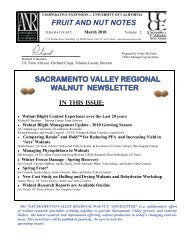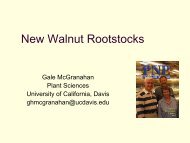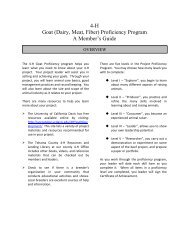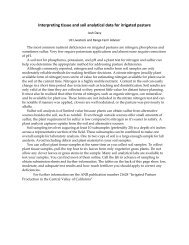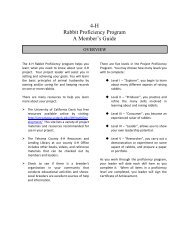Crown Gall Disease Control
Crown Gall Disease Control
Crown Gall Disease Control
- No tags were found...
You also want an ePaper? Increase the reach of your titles
YUMPU automatically turns print PDFs into web optimized ePapers that Google loves.
CFU/g soilAerobic Bacteria Recolonization1.00E+071.00E+061.00E+05ABCCABCC1.00E+041.00E+031.00E+021.00E+011.00E+000 10 20 30 40 50 60 70 80 90 100 110 120days after reintroductionMeBr Native C35 Sterile
log CFU/g soilA. tumefaciens Recolonization1.00E+07A1.00E+061.00E+05BCBAA1.00E+041.00E+03AB1.00E+021.00E+011.00E+000 10 20 30 40 50 60 70 80 90 100 110 120days after reintroductionCMeBr Native C35 Sterile
Conclusions• MeBr and most alternatives control A. tumefaciens– 1,3-D only “reduces” A. tumefaciens populations– A combination of 1,3-D and chloropicrin (Telone C35) bestalternative for control of Agrobacterium tumefaciens/crown gall• Fumigation alters the soil microbial community; result,pathogens can re-colonize to higher levels than in nonfumigatedsoil
Long term soil survivala) C35 trt soilb) Native soil+A. tumefaciensSoil surface18inDig up pouch aftergiven time intervalTwo soil conditions: a.) fallowb.) orchardDetermine A. tumefacienspopulations in soil pouches
A. tumefacienspopulationsSoil Survival of A. tumefaciensOrchard Row1.00E+071.00E+061.00E+051.00E+041.00E+031.00E+021 2 3 4 5 6 7Sample TimesC35 treated soilNative Soil1. Time 02. 7 days3. 70 days4. 110 days5. 210 days6. 270 days7. 365 days
<strong>Control</strong> of <strong>Crown</strong> <strong>Gall</strong> <strong>Disease</strong>• Fumigation/Chemical <strong>Control</strong>• Plant Clean Paradox Seeds• Systemic movement of Agrobacterium• Resistant Juglans Genotypes• Cultural PracticesPost Cold Storage HandlingSurface disinfestationlimit wounding• Surgical/chemical removal of tumors• Biological <strong>Control</strong>, i.e. K84
Tracking the origin/importance of A. tumefaciensinfection in/on Paradox seedsUSDA-ARS CPGRU Davis, CA
Does Agrobacterium tumefacienscontaminate hybrid seed?Scenario 1.source of inoculum?…mother tree?…orchard floor?Scenario 2.
outline• Mother Block Survey– Where does the A. tumefaciens inoculum come from?…mother tree?…orchard floor?
Directly off treeOff orchard floor(1,3,7,14,28 days on soil)Mother Block Survey
shell/ embryoNo Agro DetectedDirectly off tree(>2000 nuts examined)No Agro Detectedhusk-inhibitorsNo Agro Detectedexterior
No Agro detected…yetshell/ embryoOff orchard floor(1,3,7,14,28 days onsoil)Virulent/AvirulentAgro. DetectedhuskVirulent/AvirulentAgro. Detectedexterior
% trees with Agro detection1201008060virulentavirulent402000 5 10 15 20 25 30daysContact with the orchard floor increases the probabilityof picking up A. tumefaciens.
% seeds with 186r (n=20)120100exterior806040husk2000 7 14 21 28daysshell/embryo
seed inoculum summary• A. tumefaciens not detected from seedscollected directly from mother trees•A. tumefaciens picked up from orchard floor•exteriorhuskshell/embryoSO WHAT ??
MeBr fumigated soil1) Biological vacuum generated by MeBr fumigatedsoil results in… no/limited microbial antagonistsNew direction: modifying soil-borne microbial communitiesin fumigated soils
Conclusions• If left on orchard floor, Paradox seeds can becomecontaminated with A. tumefaciens• Nuts harvested directly from mother trees did notcontain A. tumefaciens
<strong>Control</strong> of <strong>Crown</strong> <strong>Gall</strong> <strong>Disease</strong>• Fumigation/Chemical <strong>Control</strong>• Plant Clean Paradox Seeds• Systemic movement of Agrobacterium• Resistant Juglans Genotypes• Cultural PracticesPost Cold Storage HandlingSurface disinfestationlimit wounding• Surgical/chemical removal of tumors• Biological <strong>Control</strong>, i.e. K84
Evaluation of wild Juglans species forcrown gall resistanceDaniel Kluepfel 1 , Malli Aradhya 1 , Malendia Maccree,Jeff Moersfelder 1 , Ali McClean 1 ,and Wes Hackett 21USDA-ARS, 2 University of California Davis, CA
Goals1. Identify sources of crown gall (CG) resistance in the Juglansgermplasm collection. (USDA/ARS National Clonal GermplasmRepository in Davis, CA)2. Generate new hybrids between J. regia and select J. microcarpa (TXblack walnut) mother trees with demonstrated CG resistance.“i.e. generate new “Paradox-like” rootstocks”3. Clonally propagated cuttings from genotypes exhibiting crown gallresistance.
Walnut GermplasmOpen pollinated seedlings grown in greenhouseconditions
Walnut Germplasm ScreenInoculation methodStab technique
Walnut species screened previouslyJ. ailantifoliaJ. californicaJ. cathyensisJ. hindsiiJ. majorJ. hopeinsisJ. mandshuricaJ. microcarpaJ. nigraJ. regiaJ. sinensisPterocarya sp.J. microcarpa and Pterocarya species exhibited highestlevels of gall resistance (>3,500 seedlings examined)
Walnut germplasm screened in 2011Tree classes Tested Retained % RetainedIndividual trees 273 95 36Juglans species 6 3 50Juglans species Tested Retained % RetainedJ. ailantifolia var.cardiforum2 0 0J. californica 3 3 100J. cathayensis 16 3 19J. major 2 0 0J. mandshurica 1 0 0J. microcarpa (26 MT’s) 249 89 37
Discarded Plants
Resistant Plant
More Resistant Plants
How do we validate “resistant” plants?Rescreen all putative resistant trees after at leastone dormancy period.Test rooted cuttings derived from putative resistantplants for persistence crown gall resistance ortolerance.
2010 cuttings re-screened in 2011Species TotalcuttingsRootedcuttingsRootingefficiency2011 retestNo.cuttingsNo.retainedJ. microcarpa 333 25 7% 22 18Pterocarya sp. 47 31 66% 31 21J. ailantifolia 2 1 50% 1 1Juglans sp. 11 0 0% 0 0total total total total393 57 14% 54 40
Conclusions<strong>Crown</strong> gall resistant Juglans and Pteracarya genotypeshave been identified after screening over 3500seedlings.J. microcarpa is the most promising Juglans species testedand can be propagated clonally via rooted cuttings.Efforts are ongoing to improve rooting efficiency.This resistance will be incorporated into new hybridrootstocks with reduced crown gall susceptibility.
“Suggestions” for limiting <strong>Crown</strong> <strong>Gall</strong>Limit exposure of paradox seeds/graft wood to soil.Surface sterilize grafting tools frequently.Limit time between nursery pickup and planting.Fumigate planting hole/avoid replanting in same holeTreat bare roots with <strong>Gall</strong>trol K84(?) (no dip tanks).Limit wounding.Avoid planting too deep.Avoid mounding soil up on newly planted trees.Keep base/crown of tree dry.
<strong>Crown</strong> <strong>Gall</strong> Update:Lani Yakabi Ali McCleanMalli Aradhya Jeff Moersfelder
The “Big” PictureParadox source treePost coldstoragehandlingNut handling; drying,soaking/washing,dehusking, etc…ColdStoragehandlingPlanting; cotyledondetachment site, growthcracksGrafting/nursery digPlanting; mounding of soil,crown budsPlant stress; improper watering,woundingRoot stock susceptibility
3) Is A. tumefaciens in/on the seed?shell/ embryoexteriorhusk
<strong>Crown</strong> <strong>Gall</strong> <strong>Disease</strong>Gelvin, S.B. 2000 Annu. Rev. Plant. Physiol.
<strong>Crown</strong> <strong>Gall</strong> <strong>Disease</strong>Agrobacterium tumefaciens•soil-borne bacterium•long term persistenceA. tumefaciens on root•natural genetic engineer•widest host range of any plantpathogen (i.e. “all” dicots)Paradox is highly susceptible•good rhizosphere colonist
A. tumefaciens populationSoil Survival of A. tumefaciensFallow Soil1.00E+061.00E+051.00E+041.00E+031.00E+021.00E+011.00E+001 2 3 4 5 6 7Sample timesC35 treated soilNative soil1. Time 02. 7 days3. 70 days4. 110 days5. 210 days6. 270 days7. 365 days



